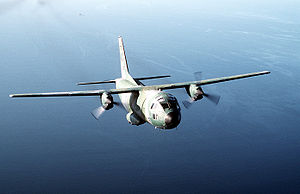Fiat G.222
| G.222 C-27A Spartan |
|
|---|---|
 |
|
| A US Air Force C-27A Spartan out of Howard AFB, Panama | |
| Role | Military transport aircraft |
| Manufacturer | Fiat / Aeritalia / Alenia Aeronautica |
| First flight | 18 July 1970 |
| Introduction | April 1978 |
| Retired | Afghan National Army Air Force 2012 |
| Status | In service |
| Primary users |
Nigerian Air Force Tunisian Air Force Argentine Army Aviation (historical) |
| Produced | 1970–1993 |
| Number built | 111 |
| Variants | Alenia C-27J Spartan |
|
|
|
|
|
The Aeritalia G.222 (formerly Fiat Aviazione, later Alenia Aeronautica) is a medium-sized STOL military transport aircraft. It was developed to meet a NATO specification, but Italy was initially the only NATO member to adopt the type. The United States purchased a small number of G.222s, designating them the C-27A Spartan.
A modernised variant, the Alenia C-27J Spartan, has been developed. While it retains many aspects of the original aircraft, the C-27J adopts the same engines and many of the systems used on the larger Lockheed Martin C-130J Super Hercules.
In 1962, NATO issued a specification for a V/STOL transport aircraft (NATO Basic Military Requirement 4), capable of supporting dispersed V/STOL fighters. Fiat's design team, led by Giuseppe Gabrielli, produced a design to meet this requirement, designated G.222; it was to be powered by two Rolls-Royce Dart turboprop engines and with six to eight Rolls-Royce RB162 lift engines to give VTOL capability. According to Aeritalia, the G.222 designation is derived from the first letter of the aircraft's chief designer; the first '2' referring to the twin-engine arrangement, and the final '22' referring to the revised NATO Basic Military Requirement 22 to which it had been submitted.
None of the submissions resulted in a production contract; however the Italian Air Force (AMI), who was at the time seeking a replacement for the Fairchild C-119 Flying Boxcar, felt that the Fiat Aviazione proposal had merit, and placed an order for two prototypes and a ground-test airframe in 1968. The G.222 was substantially redeveloped from the NATO submission, the V/STOL lift engines having been omitted completely and the conventional Dart engines replaced by a pair of General Electric T64s; the twin-boom tail featured on the V/STOL concept was also eliminated and replaced by a more conventional single tail configuration; subsequently the new aircraft had no V/STOL capability but retained considerable short take-off/landing (STOL) performance.
...
Wikipedia
